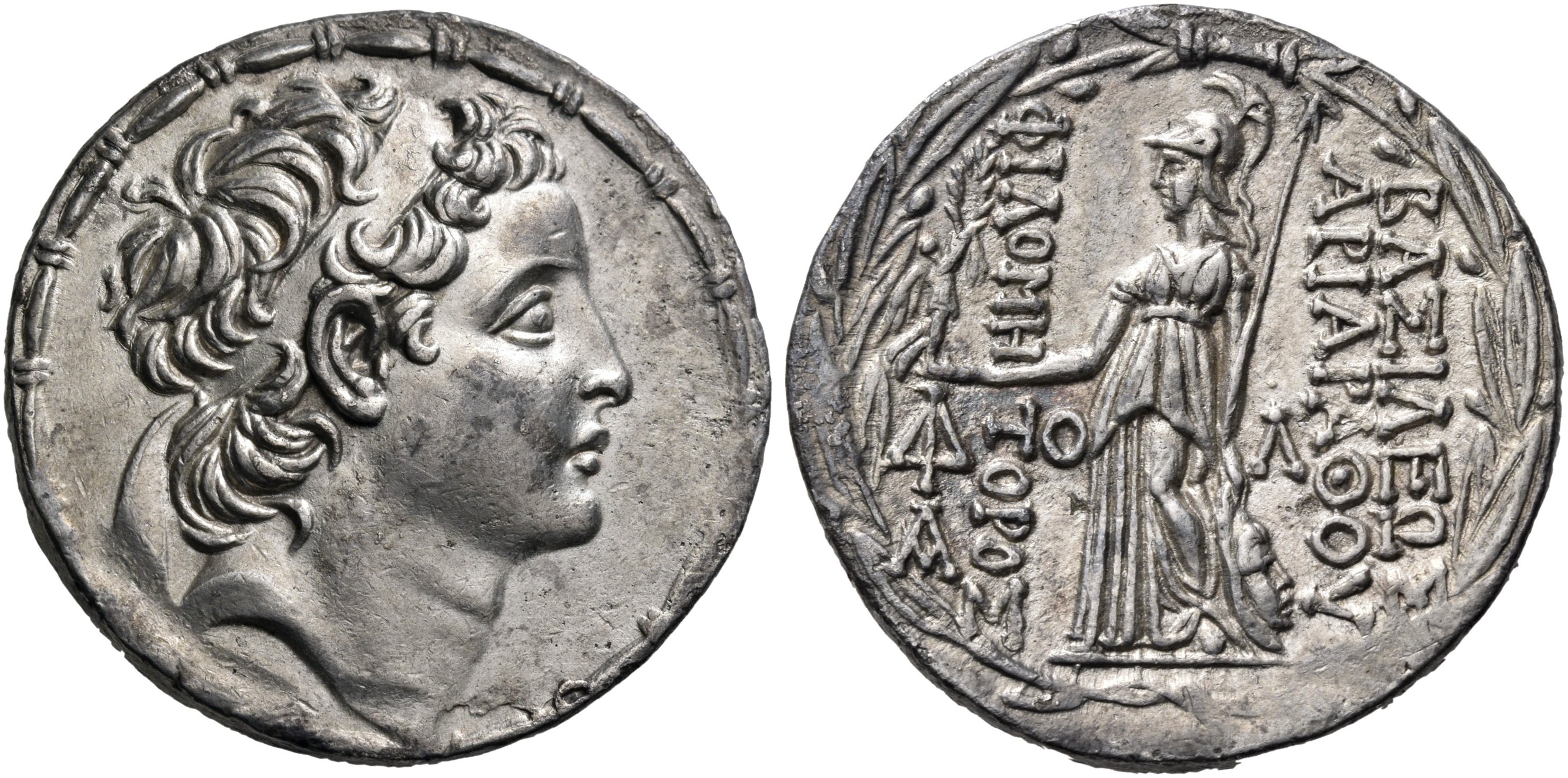Eusebeia (Ariarathes VII), silver, tetradrachms (Ariarathes VII/Athena nicephorus) (115-101 BCE)
From SILVER
115 BCE - 101 BCE Silver 1,616 kg
Description
| ObverseInscription or printing placed on the obverse.: | Diademed head r., fillet border |
| ReverseInscription or printing placed on the reverse.: | ΒΑΣΙΛEΩΣ / ΑΡΙΑΡΑΘΟΥ - ΦΙΛΟΜΗ - ΤΟΡΟΣ (Greek).Athena Nikephoros standing l., resting hand on shield ornamented with Gorgoneion, transverse spear behind her, on l., monogram above A, and O, on r., Λ, all within laurel wreath |
Mint and issuing power
| MintIdentifies the place of manufacture or issue of a numismatic object.: | Eusebeia | Ancient regionAncient region.: | Cappadocia | Modern countryModern country: Turkey | AuthorityIdentifies the issuing power. The authority can be "pretended" when the name or the portrait of X is on the coin but he/she was not the issuing power. It can also be "uncertain" when there is no mention of X on the coin but he/she was the issuing power according to the historical sources: | Ariarathes VII Philometor (king of Cappadocia, c. 116-c. 100 BC) |
Chronology
| FromIdentifies the initial date in a range assigned in a numismatic context. | 115 BCE | toIdentifies the final date in a range assigned in a numismatic context.. | 101 BCE | PeriodTime period of the numismatic object.: Hellenistic 323-30 BC |
Physical description
| MetalThe physical material (usually metal) from which an object is made.: | Silver |
Median weightMedian of the weights of numismatic objects (in grams). in grams | 16.80 | DenominationTerm indicating the value of a numismatic object. Examples: tetradrachm, chalkous, denarius.: | tetradrachm |
StandardStandard.: | Attic |
Image

S1798 Ariarathes VII tetradrachms.jpg [1]
References
| Die study referencePublication of the study: | |||
| Coin series referenceReference to coin series study: | Sear II1Sear II, n° 7290A | ||
Obverse dies distribution
no distribution is available
Reverse dies distribution
no distribution is available
Quantification
| Number of obversesNumber of obverse dies. ᵖ (o) | 2 | Number of singletons (o1)The number of singleton coins. ᵖ | 1 |
| Number of reverse diesNumber of reverse dies. (r) | 2 | Number of coinsNumber of coins. (n) | 3 |
| Coins per obverse dieNumber of coins per obverse die. (n/o) | 1.5 | Coins per reverse dieNumber of coins per reverse die. (n/r) | 1.5 |
| Reverse per obverse ratioRatio of obverse dies divided by reverse dies. (r/o) | 1 | Percentage of singletons (o1)number of coins (n) divided by the number of singletons (o1) ᵖ | 50 % |
| Original number of dies (O) (Carter 1983 formula)The estimation of the number of coins according to Carter 1983 ᵖ | 4.81 | Coins struck if 20,000 as average productivity per dieCoins made if the average productivity for obverses (according to Carter) is 20,000. ᵖ | 96,200 |
| Original number of dies (O) (Esty 2011 formula)The estimation of the number of coins according to the singleton formula in Esty 2011 ᵖ (O) | 6 | Survival rate if 20,000 as average productivity per dieSurvival rate if average productivity is 20,000. ᵖ | 0.00003 |
| Coverage (o = % of O) (Esty 1984 formula)Esty 1984 - coverage (% of O) ᵖ (o = % of O) | 66.67% | Die productivity if survival rate 1/2,000Average productivity if survival rate is 1/2,000. ᵖ | 1,247.4 |
| Weight of silver (in kg) if 20,000 coins per die (O = Carter formula)Carter 1983 * Median weight * 20000 (*10 if gold or electrum) ᵖ | 1,616 kg <br /> 1,616 kg | Die productivity if survival rate 1/5,000Average productivity if survival rate is 1/5,000. ᵖ | 3,118.5 |
Remarks
Most likely one single workstation
"Expression error: Missing operand for *." is not a number. "Expression error: Missing operand for *." is not a number.
References
- ^ Sear, David R. (1979), Greek coins and their values. Vol. II, Asia and North Africa, London, xlviii, p. 317-762